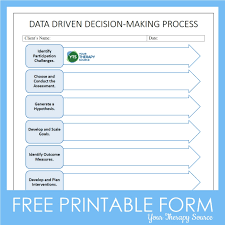Data-Based Decision Management: Harnessing the Power of Information
In today’s fast-paced and interconnected world, businesses and organizations are constantly faced with a multitude of decisions that can significantly impact their success. Whether it’s determining the most effective marketing strategy, optimizing operational processes, or making critical financial decisions, the ability to make informed choices is crucial. This is where data-based decision management comes into play.
Data-based decision management is a systematic approach that leverages data and analytics to inform and guide decision-making processes. It involves collecting, analyzing, and interpreting relevant data to gain insights that can drive better outcomes. By relying on empirical evidence rather than intuition or guesswork, organizations can make more accurate and objective decisions.
One of the key advantages of data-based decision management is its ability to minimize biases and subjectivity. Human judgment can be influenced by personal experiences, emotions, or cognitive biases. By relying on data-driven insights instead, organizations can reduce the risk of making decisions based on flawed assumptions or incomplete information.
Furthermore, data-based decision management allows for a more proactive approach rather than a reactive one. Instead of waiting for problems to arise before taking action, organizations can use historical and real-time data to identify patterns, trends, and potential issues in advance. This enables them to take preventive measures or capitalize on emerging opportunities before they become critical.
Implementing an effective data-based decision management strategy requires several key components. First and foremost is the collection of high-quality data from reliable sources. This may involve integrating various systems within an organization to gather relevant information in a centralized location.
Next comes the analysis phase where advanced analytics techniques are applied to extract meaningful insights from the collected data. This could involve using statistical models, machine learning algorithms, or visualization tools to uncover patterns or correlations that may not be apparent at first glance.
Once insights are obtained from the analysis stage, they need to be communicated effectively to decision-makers within the organization. Visualizations, dashboards, and reports can be used to present the findings in a clear and understandable manner. This empowers decision-makers to make evidence-based choices with confidence.
Lastly, data-based decision management is an iterative process. It requires continuous monitoring and evaluation of outcomes to assess the effectiveness of decisions made. By measuring the impact of decisions against predetermined metrics, organizations can refine their strategies and improve future decision-making processes.
In conclusion, data-based decision management is a powerful approach that enables organizations to make well-informed choices backed by empirical evidence. By leveraging data and analytics, organizations can minimize biases, proactively address challenges, and capitalize on opportunities. With the right data-driven strategy in place, businesses and organizations can navigate today’s complex landscape with confidence and achieve their desired outcomes.
6 Essential Tips for Effective Data-Based Decision Management
- Establish a data-driven culture
- Collect the right data
- Analyze and interpret the data
- Monitor performance metrics
- Communicate results clearly
- Review outcomes regularly
Establish a data-driven culture
Establishing a Data-Driven Culture: Unlocking the Potential of Data
In the era of big data, organizations are sitting on a goldmine of valuable information that can drive better decision-making and improve overall performance. However, simply having access to data is not enough. To truly harness its power, organizations must establish a data-driven culture that permeates throughout the entire organization.
A data-driven culture is one where data is not just seen as a byproduct of operations but rather as a strategic asset. It involves instilling a mindset within the organization that encourages employees at all levels to leverage data in their day-to-day activities and decision-making processes.
One key aspect of establishing a data-driven culture is fostering awareness and understanding among employees about the value and potential of data. This can be achieved through training programs, workshops, or internal communications that highlight how data can provide insights, improve efficiency, and drive innovation.
Moreover, organizations need to invest in the necessary infrastructure and tools to collect, store, process, and analyze data effectively. This may involve implementing robust data management systems, employing analytics platforms or hiring skilled professionals who can handle complex data tasks.
Leadership plays a crucial role in promoting a data-driven culture. Executives and managers should lead by example by incorporating data into their decision-making processes. When employees see their leaders relying on evidence-based insights rather than gut feelings or personal biases, they are more likely to follow suit.
Another important aspect is fostering collaboration across different departments or teams within the organization. Breaking down silos allows for cross-functional sharing of information and insights derived from different sources of data. This collaborative approach enables organizations to gain holistic perspectives on challenges and opportunities.
Furthermore, organizations should establish clear goals and metrics tied to their strategic objectives. By aligning these goals with key performance indicators (KPIs) that are measurable using relevant data points, it becomes easier to track progress and make informed decisions based on real-time information.
Lastly, a data-driven culture requires continuous learning and improvement. Organizations should encourage experimentation and provide a safe space for employees to test hypotheses, analyze results, and learn from failures. This iterative process fosters a culture of curiosity, innovation, and continuous improvement.
In conclusion, establishing a data-driven culture is essential for organizations seeking to unlock the full potential of their data. By fostering awareness, investing in infrastructure, promoting leadership buy-in, encouraging collaboration, setting clear goals, and embracing a learning mindset, organizations can create an environment where data becomes a valuable asset that drives decision-making at all levels. Embracing a data-driven culture is not only about leveraging the power of data but also about cultivating an organizational mindset that values evidence-based insights and empowers employees to make better decisions for the future success of the organization.
Collect the right data
Collecting the Right Data: The Foundation of Effective Decision Making
Data-based decision management relies heavily on the quality and relevance of the data being collected. In order to make informed choices, organizations must ensure they are collecting the right data. This crucial step sets the foundation for effective decision making.
When it comes to collecting data, quantity is not always better than quality. It’s important to focus on gathering information that is directly related to the decision at hand. This means identifying key metrics, variables, or indicators that will provide valuable insights and support the decision-making process.
To collect the right data, organizations should start by clearly defining their objectives and what specific information they need to achieve those goals. By having a clear understanding of what they are trying to accomplish, organizations can narrow down their focus and avoid wasting resources on irrelevant or unnecessary data.
Another important aspect is ensuring the accuracy and reliability of the collected data. Inaccurate or unreliable data can lead to flawed analysis and ultimately poor decision making. Organizations should establish robust processes for data collection, including regular checks for errors or inconsistencies, and implement measures to maintain data integrity.
In addition, organizations should consider both internal and external sources of data. Internal sources may include existing databases, customer feedback systems, or operational records. External sources could include market research reports, industry benchmarks, or public datasets. By combining internal and external data sources, organizations can gain a more comprehensive view of their decision-making landscape.
Furthermore, it’s essential to collect data consistently over time. Decision making often requires analyzing trends or patterns that emerge over a period of time. By consistently collecting relevant data points at regular intervals, organizations can track changes and make more accurate predictions about future outcomes.
Lastly, it’s important to stay agile in data collection practices. As technologies evolve and new tools become available, organizations should be open to exploring innovative ways of gathering data. Automation tools, artificial intelligence algorithms, or Internet of Things (IoT) devices can offer new opportunities for data collection that may not have been possible before.
In conclusion, collecting the right data is a critical step in data-based decision management. By focusing on quality over quantity, ensuring accuracy and reliability, considering both internal and external sources, collecting data consistently, and staying agile in data collection practices, organizations can lay the groundwork for effective decision making. With the right data in hand, organizations can gain valuable insights and make informed choices that drive success.
Analyze and interpret the data
Analyzing and Interpreting Data: Unleashing the Power of Insights
In the realm of data-based decision management, one crucial step stands out among the rest: analyzing and interpreting the data. Collecting vast amounts of data is meaningless without extracting meaningful insights that can drive informed decision-making.
Data analysis involves examining the collected information to identify patterns, trends, correlations, and outliers. It is through this process that organizations can uncover valuable insights that may not be immediately apparent. By applying various analytical techniques, such as statistical models or machine learning algorithms, organizations can transform raw data into actionable knowledge.
Interpreting the analyzed data is equally important. It involves making sense of the insights obtained and understanding their implications for decision-making. Interpretation requires a deep understanding of the context in which the data was collected and an ability to connect it to organizational goals or challenges.
When analyzing and interpreting data, it’s essential to consider both quantitative and qualitative aspects. Quantitative analysis focuses on numerical data, allowing for statistical comparisons and measurements. On the other hand, qualitative analysis delves into non-numerical information like text or open-ended responses, providing valuable context and narrative.
Effective interpretation also requires critical thinking skills. Decision-makers must question assumptions, challenge biases, and consider alternative explanations for the observed patterns or trends. This helps ensure that decisions are based on a comprehensive understanding of the data rather than superficial observations.
Moreover, visualization plays a vital role in presenting analyzed data in a clear and understandable manner. Graphs, charts, dashboards, or infographics can help communicate complex findings effectively to stakeholders who may not have expertise in data analysis. Visualizations enhance comprehension by highlighting key insights and facilitating comparisons or trends identification.
By investing time and effort into thorough analysis and interpretation of data, organizations gain several benefits. They can identify areas for improvement within their operations or strategies based on evidence rather than assumptions. They can also uncover hidden opportunities that may have gone unnoticed without a deep dive into the data.
Furthermore, analyzing and interpreting data fosters a culture of evidence-based decision-making. Organizations become more confident in their choices, knowing they are grounded in empirical evidence. This approach minimizes the risks associated with subjective decision-making and increases the likelihood of success.
In conclusion, analyzing and interpreting data is a crucial step in data-based decision management. It transforms raw information into valuable insights that drive informed choices. By leveraging both quantitative and qualitative analysis techniques, organizations can unlock the power of their data and make decisions that lead to positive outcomes.
Monitor performance metrics
Monitoring Performance Metrics: Key to Effective Data-Based Decision Management
In the realm of data-based decision management, one invaluable tip that can significantly enhance decision-making processes is monitoring performance metrics. Performance metrics serve as vital indicators of how well an organization is progressing towards its goals and objectives. By closely monitoring these metrics, businesses can gain valuable insights into their performance and make informed decisions based on real-time data.
Performance metrics can vary depending on the nature of the organization and its specific goals. They may include key performance indicators (KPIs) such as sales revenue, customer satisfaction ratings, production efficiency, or website traffic. The important aspect is to identify the most relevant metrics that align with the organization’s objectives.
Regularly tracking performance metrics provides several benefits for effective decision management. Firstly, it allows organizations to identify trends and patterns over time. By analyzing historical data, they can uncover recurring patterns or fluctuations that may impact decision-making processes. For example, a sudden drop in customer satisfaction ratings may prompt a closer examination of customer service practices or product quality.
Additionally, monitoring performance metrics enables organizations to detect potential issues or bottlenecks before they escalate into significant problems. For instance, if production efficiency starts declining gradually over time, it can serve as an early warning sign for operational inefficiencies that need to be addressed promptly.
Furthermore, tracking performance metrics facilitates benchmarking against industry standards or competitors’ performance. This comparison provides valuable insights into areas where an organization may be falling behind or excelling in relation to others in the same field. This information can guide decision-makers in setting realistic targets and making strategic adjustments accordingly.
To effectively monitor performance metrics, organizations should establish a robust data collection and reporting system. This involves implementing tools and technologies that automate the process of gathering relevant data from various sources and presenting it in a clear and easily understandable format.
Moreover, it is crucial to establish a regular cadence for reviewing and analyzing performance metrics. Whether it’s on a weekly, monthly, or quarterly basis, consistent monitoring ensures that decision-makers have access to the most up-to-date information when making critical choices.
In conclusion, monitoring performance metrics is an indispensable tip for effective data-based decision management. By closely tracking relevant indicators, organizations can gain valuable insights into their performance, detect potential issues early on, and make informed decisions based on real-time data. Embracing this practice allows businesses to adapt quickly to changing circumstances and stay ahead in today’s dynamic and competitive landscape.
Communicate results clearly
Communicate Results Clearly: A Key Tip for Data-Based Decision Management
In the realm of data-based decision management, one crucial tip that cannot be overlooked is the clear communication of results. While collecting and analyzing data is essential, it is equally important to effectively communicate the insights gained from that data to key stakeholders within an organization.
Clear communication ensures that decision-makers fully understand the implications of the data-driven insights and can make informed choices based on that information. When results are communicated clearly, it eliminates confusion, misunderstandings, and misinterpretations that can lead to flawed decision-making.
So, how can organizations ensure they communicate results clearly? Here are a few strategies:
- Use Visualizations: Visualizing data through charts, graphs, and infographics can help simplify complex information. Visual representations make it easier for stakeholders to grasp key trends, patterns, and relationships within the data quickly.
- Tailor Communication to the Audience: Different stakeholders may have varying levels of technical expertise or familiarity with data analysis. It’s important to adapt your communication style accordingly. Avoid jargon and technical terms when presenting to non-technical audiences while providing more in-depth analysis for those who are well-versed in data.
- Provide Context: Simply presenting numbers or statistics without context can be confusing or misleading. It’s crucial to provide relevant context by explaining what the data represents, how it was collected, any limitations or assumptions made during analysis, and what implications the findings may have on decision-making.
- Highlight Key Insights: Rather than overwhelming stakeholders with an abundance of information, focus on highlighting the most critical insights derived from the data analysis. Identify key trends or patterns that directly relate to the decisions at hand and emphasize their significance.
- Encourage Questions and Discussion: Foster an environment where stakeholders feel comfortable asking questions and engaging in discussions about the presented results. This helps ensure clarity and allows for a deeper understanding of the implications of the data.
By following these strategies and emphasizing clear communication of results, organizations can maximize the impact of their data-based decision management efforts. Clear communication ensures that decision-makers are equipped with the necessary information to make informed choices, leading to more effective and successful outcomes.
Remember, data-driven insights are only valuable if they are effectively communicated. So, make it a priority to communicate results clearly and empower your organization to make data-informed decisions with confidence.
Review outcomes regularly
Review Outcomes Regularly: A Key Tip for Data-Based Decision Management
In the realm of data-based decision management, one crucial tip stands out among the rest: reviewing outcomes regularly. While collecting and analyzing data is essential, it’s equally important to assess the impact of decisions made based on that data.
Regularly reviewing outcomes allows organizations to evaluate the effectiveness of their decisions and make necessary adjustments. It provides an opportunity to measure performance against predetermined metrics and identify areas for improvement.
By monitoring outcomes, organizations can gain valuable insights into the success or failure of their decision-making processes. They can identify patterns, trends, and correlations that may have influenced the results. This information can then be used to refine strategies and enhance future decision-making efforts.
Moreover, reviewing outcomes regularly promotes a culture of learning and continuous improvement within an organization. It encourages teams to reflect on their decisions, understand what worked well, and identify areas that need attention. This iterative process helps build knowledge and expertise over time, leading to more informed decision-making in the future.
To effectively review outcomes, organizations should establish clear evaluation criteria and metrics aligned with their goals. These metrics could include financial performance indicators, customer satisfaction ratings, or operational efficiency measures. By defining these benchmarks in advance, organizations can objectively assess whether decisions have met expectations or fallen short.
It’s also important to involve stakeholders in the outcome review process. By seeking input from individuals directly impacted by decisions or those responsible for implementation, organizations can gain diverse perspectives and insights. This collaborative approach fosters a sense of ownership among team members and increases the likelihood of identifying valuable lessons learned.
In conclusion, regular outcome reviews are a vital component of successful data-based decision management. By evaluating the impact of decisions made based on data-driven insights, organizations can continuously improve their strategies and achieve better results over time. Embracing this tip fosters a culture of learning and empowers organizations to make more informed choices moving forward.




